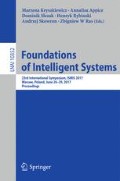Abstract
Many existing approaches to clustering are based on a two-way strategy that does not adequately show the fact that a cluster may not have a well-defined boundary. In this paper, we propose a Contraction and Expansion Re-clustering (C&E Re-clustering for short) model based on three-way strategy. The model utilizes the ideas of erosion and dilation in mathematical morphology. Contraction is used to shrink clusters while expansion is used to stretch clusters obtained by using an existing clustering algorithm. The difference between the results of contraction and expansion is regarded as the fringe region of the specific cluster. Therefore, a three-way explanation of the cluster is naturally formed. A C&E NJW re-clustering algorithm is proposed and the results on synthetic data set show that such a strategy is effective in improving the structure of clustering results.
Access this chapter
Tax calculation will be finalised at checkout
Purchases are for personal use only
References
Aydin, N., Naït-Abdesselam, F., Pryyma, V., Turgut, D.: Overlapping clusters algorithm in ad hoc networks. In: 2010 IEEE Global Telecommunications Conference (2010)
Donath, W., Hoffman, A.J.: Lower bounds for the partitioning of graphs. IBM J. Res. Dev. 17, 420–425 (1973)
Hoppner, F., Klawonn, F., Kruse, R., Runkler, T.: Fuzzy Cluster Analysis: Methods for Classification, Data Analysis and Image Recognition. Wiley, Chichester (1999)
Lingras, P., Hogo, M., Snorek, M., West, C.: Temporal analysis of clusters of supermarket customers: conventional versus interval set approach. Inf. Sci. 172, 215–240 (2005)
Lingras, P., West, C.: interval set clustering of web users with rough k-means. J. Intell. Inf. Syst. 23, 5–16 (2004)
Luxburg, U.: A tutorial on spectral clustering. Stat. Comput. 17, 395–416 (2007)
Matheron, G.: Random Sets and Integral Geometry. Wiley, New York (1975)
Ng, A., Jordan, M., Weiss, Y.: On spectral clustering: analysis and an algorithm. In: Dietterich, T., Becker, S., Ghahramani, Z. (eds.) Advances in Neural Information Processing Systems 14, pp. 849–856. MIT Press, Cambridge (2002)
Shi, J., Malik, J.: Normalized cuts and image segmentation. IEEE Trans. Pattern Anal. Mach. Intell. 22, 888–905 (2000)
Serra, J.: Image Analysis and Mathematical Morphology. Academic Press, London (1982)
Stell, J.G.: Relations in mathematical morphology with applications to graphs and rough sets. In: Winter, S., Duckham, M., Kulik, L., Kuipers, B. (eds.) COSIT 2007. LNCS, vol. 4736, pp. 438–454. Springer, Heidelberg (2007). doi:10.1007/978-3-540-74788-8_27
Takaki, M., Tamura, K., Mori, Y.: A extraction method of overlapping cluster based on network structure analysis. In: IEEE/WIC/ACM International Conferences on Web Intelligence and Intelligent Agent Technology, pp. 212–217 (2007)
Yao, Y.Y.: Three-way decisions with probabilistic rough sets. Inf. Sci. 180, 341–353 (2010)
Yao, Y.: An outline of a theory of three-way decisions. In: Yao, J.T., Yang, Y., Słowiński, R., Greco, S., Li, H., Mitra, S., Polkowski, L. (eds.) RSCTC 2012. LNCS (LNAI), vol. 7413, pp. 1–17. Springer, Heidelberg (2012). doi:10.1007/978-3-642-32115-3_1
Yao, Y.Y.: Three-way decisions and cognitive computing. Cogn. Comput. 8, 543–554 (2016)
Yu, H., Zhang, C., Wang, G.: A tree-based incremental overlapping clustering method using the three-way decision theory. Knowl.-Based Syst. 91, 189–203 (2016)
Yu, H., Jiao, P., Yao, Y.Y., Wang, G.: Detecting and refining overlapping regions in complex networks with three-way decisions. Inf. Sci. 373, 21–41 (2016)
Acknowledgements
This work was supported in part by National Natural Science Foundation of China (Nos. 61503160 and 61572242), Natural Science Foundation of the Jiangsu Higher Education Institutions of China (No. 15KJB110004), and a Discovery Grant from NSERC, Canada.
Author information
Authors and Affiliations
Corresponding author
Editor information
Editors and Affiliations
Rights and permissions
Copyright information
© 2017 Springer International Publishing AG
About this paper
Cite this paper
Wang, P., Yang, X., Yao, Y. (2017). C&E Re-clustering: Reconstruction of Clustering Results by Three-Way Strategy. In: Kryszkiewicz, M., Appice, A., Ślęzak, D., Rybinski, H., Skowron, A., Raś, Z. (eds) Foundations of Intelligent Systems. ISMIS 2017. Lecture Notes in Computer Science(), vol 10352. Springer, Cham. https://doi.org/10.1007/978-3-319-60438-1_53
Download citation
DOI: https://doi.org/10.1007/978-3-319-60438-1_53
Published:
Publisher Name: Springer, Cham
Print ISBN: 978-3-319-60437-4
Online ISBN: 978-3-319-60438-1
eBook Packages: Computer ScienceComputer Science (R0)

